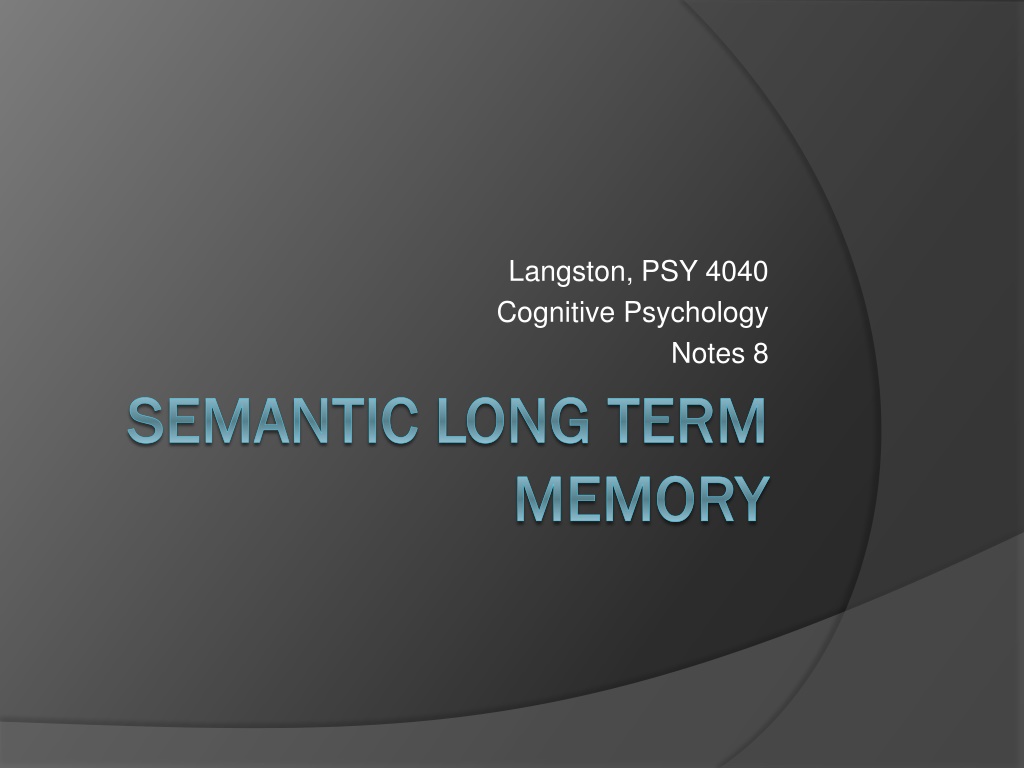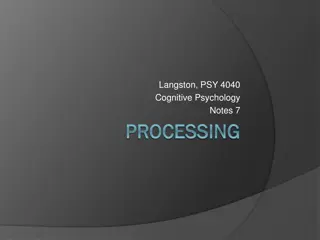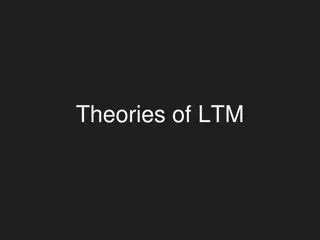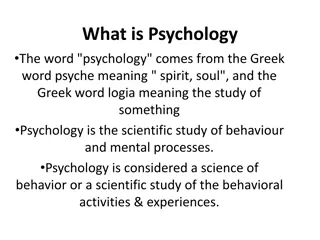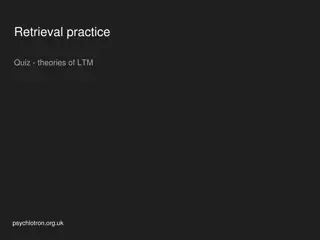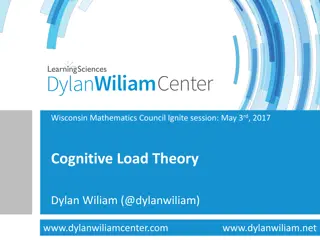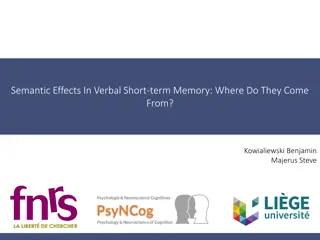Understanding Semantic Memory Models in Cognitive Psychology
Explore the structure and processes of semantic memory through traditional and neural network views. Delve into symbolic and network models, such as Collins & Quillian's 1970 model, which organize concepts as nodes and links, depicting relationships between concepts within semantic memory representation.
Download Presentation

Please find below an Image/Link to download the presentation.
The content on the website is provided AS IS for your information and personal use only. It may not be sold, licensed, or shared on other websites without obtaining consent from the author. Download presentation by click this link. If you encounter any issues during the download, it is possible that the publisher has removed the file from their server.
E N D
Presentation Transcript
Langston, PSY 4040 Cognitive Psychology Notes 8 SEMANTIC LONG TERM SEMANTIC LONG TERM MEMORY MEMORY
Where We Are We re looking at long term memory. We started with episodic long term memory and processing. For this unit, we ll look at semantic long term memory.
Where We Are Here are the boxes: Working Memory (STM) LTM Executive Episodic Sensory Store AL VSS Semantic Input Response (Environment)
Questions What is the structure of the representation in semantic memory? We ll look at two views: Traditional models. Neural networks. What processes act on the representation? Encoding: I ll probably leave you less than satisfied on this one. Retrieval: How do you get information out?
Models of Semantic Memory Symbolic models: A symbolic model uses symbols (something that stands for something else). For instance, the word moon is a symbol for the thing in the sky. Symbols are discrete. There is no inherent relationship between the symbol and the thing being represented (this is becoming a topic of discussion). Cognition involves manipulating symbols.
Models of Semantic Memory Symbolic models: A symbolic model uses symbols: The analogy is to language. You arrange language symbols to represent meaning ( The dog bit the man is different from The man bit the dog ). At the cognitive level, you arrange your symbols to produce meaning. Note that the symbols are not words or units we would think of as language. Our first set of models will all be symbolic.
Models of Semantic Memory Network models (Collins & Quillian, 1970): Concepts are organized as a set of nodes and links between those nodes. Nodes hold concepts. For example, you would have a node for RED, FIRE, FIRETRUCK, etc. Each concept you know would have a node. Links connect the nodes and encode relationships between them. Two kinds: Superset/subset: Essentially categorize. For example, ROBIN is a subset of BIRD. Property: Labeled links that explain the relationship between various properties and nodes. For example, WINGS and BIRD would be connected with a has link.
Models of Semantic Memory Network models (Collins & Quillian, 1970): Here s a sample of a network: Collins & Quillian (1970, p. 305)
Models of Semantic Memory Network models (Collins & Quillian, 1970): The nodes are arranged in a hierarchy and distance (number of links traveled) matters. The farther apart two things are, the less related they are. This is going to be important in predicting performance. The model has a property called cognitive economy. Concepts are only stored once at the highest level to which they apply (e.g., BREATHES is stored at the ANIMAL node instead of with each individual animal). This was based on the model s implementation on early computers and may not have a brain basis. Also, not necessarily crucial for the model.
Models of Semantic Memory Network models (Collins & Quillian, 1970): Evidence: When people do a semantic verification task, you see evidence of a hierarchy (response times are correlated with the number of links). Superset (category): A canary is a canary (S0) A canary is a bird (S1) A canary is an animal (S2) Property: Number of links: A canary can sing (P0) A canary can fly (P1) A canary has skin (P2) 0 1 2
Models of Semantic Memory Network models (Collins & Quillian, 1970): Collins & Quillian (1970, p. 306; reporting data from Collins & Quillian, 1969)
Models of Semantic Memory Network models (Collins & Quillian, 1970): The CogLab exercise on lexical decision is relevant here, so we ll look at the data
Models of Semantic Memory Network models: Problems: Typicality: Typicality seems to influence responses. Technically, a robin is a bird and a chicken is a bird are each one link. But, the robin is more typical. What is that in the network? Shows up in reaction times as well.
Models of Semantic Memory Smith, Shoben, & Rips (1974, p. 218)
Models of Semantic Memory Network models: Problems: With the hierarchy: A horse is an animal is faster than A horse is a mammal which violates the hierarchy. A chicken is more typical of animal than a robin, a robin is more typical of bird than a chicken. How can a network account for this (Smith, Shoben, & Rips, 1974)?
Models of Semantic Memory Network models: Problems: Answering no : You know the answer to a questions is no (e.g., a bird has four legs ) because the concepts are far apart in the network. But, some no responses are really fast (e.g., a bird is a fish ) and some are really slow (e.g., a whale is a fish ). The reason for this isn t obvious in the model. Loosely speaking, a bat is a bird is true, but how does a network model do it (Smith, Shoben, & Rips, 1974)?
Models of Semantic Memory Feature models (Smith, Shoben, & Rips, 1974): Concepts are clusters of semantic features. There are two kinds: Distinctive features: Core parts of the concept. They must be present to be a member of the concept, they re the defining features. For example, WINGS for BIRD. Characteristic features: Typically associated with the concept, but not necessary. For example, CAN FLY for BIRD.
Models of Semantic Memory Smith, Shoben, & Rips (1974, p. 216)
Models of Semantic Memory Feature models (Smith, Shoben, & Rips, 1974): Why have defining and characteristic features? Various evidence, such as hedges: Smith, Shoben, & Rips (1974, p. 217)
Models of Semantic Memory Feature models (Smith, Shoben, & Rips, 1974): A linguistic hedge is a kind of categorization statement. A robin is a true bird. A true is a hedge that puts robin strongly in the bird category. Technically speaking, a whale is a mammal. Technically speaking acknowledges that whales aren t ideal representations of the mammal category. A hedge works as longs as it respects the types of features on the last slide.
Models of Semantic Memory Feature models (Smith, Shoben, & Rips, 1974): Why characteristic features? Various evidence, such as hedges: OK: A robin is a true bird. Has both defining and characteristic. Technically speaking, a chicken is a bird. Has defining features of what a bird is, but not the characteristic features.
Models of Semantic Memory Feature models (Smith, Shoben, & Rips, 1974): Why characteristic features? Various evidence, such as hedges: Feels wrong: Technically speaking, a robin is a bird. It has both, so you re using the wrong hedge. A chicken is a true bird. It lacks characteristic, so you wouldn t say it like this.
Models of Semantic Memory Feature models (Smith, Shoben, & Rips, 1974): Answering a semantic verification question is a two-step process. Compare on all features. If there is a lot of overlap it s an easy yes. If there is almost no overlap, it s an easy no. In the middle, go to step two. Compare distinctive features. This involves an extra stage and should take longer.
Models of Semantic Memory Feature models (Smith, Shoben, & Rips, 1974): Some examples: BIRD Wings Feathers MAMMAL Nurses-young Warm-blooded Live-birth Four-legs Distinctive Characteristic Flies Small ROBIN Wings Feathers WHALE Swims Live-birth Nurses-young Large Distinctive Characteristic Red-breast
Models of Semantic Memory Feature models (Smith, Shoben, & Rips, 1974): Some questions: Easy yes A robin is a bird Easy no A robin is a fish Hard yes A whale is a mammal Hard no A whale is a fish
Models of Semantic Memory Feature models (Smith, Shoben, & Rips, 1974): Evidence: We can account for: Typicality effects: One step for more typical members, two steps for less typical members, that explains the time difference. Answering no : Why are no responses different? Depends on the number of steps (feature overlap). Hierarchy: Since it isn t a hierarchy but similarity, we can understand why different types of decisions take different amounts of time.
Models of Semantic Memory Feature models (Smith, Shoben, & Rips, 1974): Problem: How do we get the distinctive features? What makes something a game? What makes someone a bachelor? How about cats? How many of the features of a bird can you lose and still have a bird? The distinction between defining and characteristic features addresses this somewhat, but it is still a problem in implementation.
Models of Semantic Memory Spreading activation (Collins & Loftus, 1975): Bring back the network model, but make some modifications: The length of the link matters. The less related two concepts are, the longer the link. This gets typicality effects (put CHICKEN farther from BIRD than ROBIN). Search is a process called spreading activation. Activate the two nodes involved in a question and spread that activation along links. The farther it goes, the weaker it gets. When you get an intersection between the two spreading activations, you can decide on the answer to the question. This model gets around a lot of the problems with the earlier network model.
Models of Semantic Memory Collins & Loftus (1975, p. 412)
Models of Semantic Memory Spreading activation (Collins & Loftus, 1975): This is probably the explanation for the false memory CogLab exercise, so we can look at the results here
Models of Semantic Memory Spreading activation (Collins & Loftus, 1975): Problem: It s kind of cheating to make your model overly powerful and build in all of the effects you re trying to account for. Having said that, this model is still around.
Models of Semantic Memory Propositional models: The elements are idea units. Meaning is represented by these idea units, their relationships, and the operations you can perform on them. For example, consider: Pat practiced from noon until dusk.
Models of Semantic Memory Propositional models: The propositions would be: (EXIST, PAT) (PRACTICE, A:PAT, S:NOON, G:DUSK) (We have this thing Pat. Pat is the agent of the verb to practice, the source of the practice is noon and the goal is dusk.) The elements of the proposition are in all caps to emphasize that they are arbitrary symbols and not words.
Models of Semantic Memory Propositional models: Propositional models can solve some problems that other models would have a hard time with. For example: Bilk is not available in all areas could mean: There is no area in which Bilk is available. Bilk is available in some areas, but not all. The ambiguity comes from the scope of the not. How much of the sentence is covered by it? A propositional model can handle this reasonably well (next slide).
Models of Semantic Memory Propositional models: There is no area in which Bilk is available. For all x, not (Bilk is available in x) Bilk is available in some areas, but not all. Not, for all x (Bilk is available in x) Where you put the not determines the interpretation.
Models of Semantic Memory Scripts and schemas (Bartlett, Schank): Knowledge is packaged in integrated conceptual structures. Scripts: Typical action sequences (e.g., going to the restaurant, going to the doctor ) Schemas: Organized knowledge structures (e.g., your knowledge of cognitive psychology). It would be possible to describe these with nodes and links, but that would mask their specialness. For example, a schema could be a sub-network related to a particular area.
Models of Semantic Memory Scripts and schemas (Bartlett, Schank): Evidence: When people see stories like this: Chief Resident Jones adjusted his face mask while anxiously surveying a pale figure secured to the long gleaming table before him. One swift stroke of his small, sharp instrument and a thin red line appeared. Then an eager young assistant carefully extended the opening as another aide pushed aside glistening surface fat so that vital parts were laid bare. Everyone present stared in horror at the ugly growth too large for removal. He now knew it was pointless to continue.
Models of Semantic Memory Scripts and schemas (Bartlett, Schank): And you ask them to recognize words that might have been part of the story, they tend to recognize material that is script or schema typical even if it wasn t presented. Let s try: Scalpel? Assistant? Nurse? Doctor? Operation? Hospital?
Models of Semantic Memory Scripts and schemas (Bartlett, Schank): And you ask them to recognize words that might have been part of the story, they tend to recognize material that is script or schema typical even if it wasn t presented. Let s try: Scalpel? No Assistant? Yes Nurse? No Doctor? No Operation? No Hospital? No I had to re-read it a surprising number of times to be sure of these answers.
Models of Semantic Memory Scripts and schemas (Bartlett, Schank): People also tend to fill in missing details from scripts and schemas if they are not provided (as long as those parts are typical). When people are told the script or schema that is appropriate before hearing some material they tend to understand it better than if they are not told it at all or are told it after the material. We ll see a lot more evidence in the language units.
Models of Semantic Memory Scripts and schemas (Bartlett, Schank): Divide into group 1 and group 2
Models of Semantic Memory Scripts and schemas (Bartlett, Schank): How are scripts organized? Let s see: Group 1: Write down everything you can think of about going to the doctor from the most central to least central action.
Models of Semantic Memory Scripts and schemas (Bartlett, Schank): How are scripts organized? Let s see: Group 2: Write down everything you can think of about going to the doctor from the first to the last action.
Models of Semantic Memory Scripts and schemas (Bartlett, Schank): How are scripts organized? We should find (as in Barsalou & Sewell, 1985) that people organize by performance and not centrality.
Models of Semantic Memory A final thought on these models: We ve considered representation and process, but we ve really left out a significant part of process. How did this information get into this format in semantic memory? Except for noting it, we will not be addressing it at this time.
Non-symbolic Models An alternative approach is to get rid of discrete nodes (in which each node holds a concept), and rearrange how we think about knowledge representation. The goal is to develop a model that is more like the way brains work. In neural network models, we still have nodes and links, but the knowledge is contained in the weights on the links and not in the nodes.
Non-symbolic Models We re going to start with the simplest neural network model, the perceptron. A perceptron is a lot like a single neuron. It can be used to: Answer questions about semantic knowledge (e.g., superset/subset relations). Learn new semantic knowledge by figuring out which features are relevant to solving a problem and how to use those features.
Non-symbolic Models Neurons: Have inputs from various sources. Weight those inputs (some excite, some inhibit). Sum the inputs multiplied by the weights. Decide based on that if they will fire. Perceptrons (artificial neurons): Have inputs from various sources. Weight those inputs and multiply. Sum and decide.
